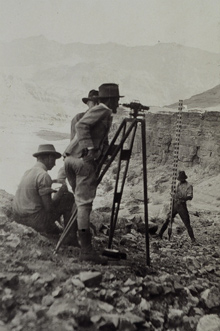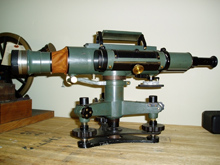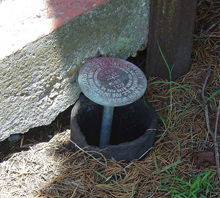Level Headed: A Brief History of Leveling at the National Geodetic Survey
Accurate models of storm surge and pollution, highway planning, effective resource management, and adequate disaster preparedness all require accurate elevations. As far back as 1817, the Survey of the Coast began determining elevations in coastal areas using trigonometric methods. Determination of very accurate elevations with instruments that were based on a bubble in a vial of liquid, called spirit leveling, replaced the less accurate trigonometric methods over time. NOAA's National Geodetic Survey continues its elevation work today, adding cutting-edge technology such as the global positioning system to its surveying toolkit.
- Introduction
- The Early History of Leveling
- The First Geodetic Level Lines
- Evolving Levels
- Official Elevation Datum
- GPS and Height Modernization
- Works Consulted
Knowledge of elevations is critical to surveyors, engineers, coastal managers, developers, and those who make resource or land-use management decisions. NOAA’s National Geodetic Survey (NGS) provides a great deal of the accurate elevation data needed by these groups to do their work successfully. However, sea level rise, subsidence (i.e., land sinking), and geological events such as earthquakes are among the many forces constantly changing the surface of the Earth. NGS responds to these changes and to changes in technology by working to develop and refine fast and accurate methods of data collection and to transfer new knowledge and techniques to the surveyors with whom the agency works in partnership.

This party is using a Fischer level to leap frog its way into Glen Canyon in 1921. Click image for larger view.
The most accurate elevation data are collected through a process called “spirit leveling,” which is performed with an instrument that is a combination of a telescope and a spirit level vial. Called a level, the instrument is used to read values from a set of specially constructed and marked rods. Leveling involves determining differences in elevation between survey points following a “leap frog” approach. Building off of known elevations and carrying elevations forward from point to point with a level and rods, surveyors construct a “level line.”
Level lines are marked by periodically placing benchmarks in the ground along the line. NGS has been in the business of leveling since the 1800s, and has placed hundreds of thousands of benchmarks across the U.S. These benchmarks are a fundamental component of the National Spatial Reference System.
As a leader in providing data and developing and using surveying technologies, NOAA continues to update elevation data across the country. This article is a brief journey through the history of leveling and its applications.
The Early History of Leveling
The science of leveling goes back to the ancient Greeks, Egyptians, and Romans and their massive construction projects. Early leveling methods used water in a container to obtain sightings that were parallel with the ground, or “level.” In the mid-1600s, Melchisedech Thevenot sealed water in a vial in such a way as to form a bubble. This vial provided the basis for the surveyor’s level developed 100 years later. A surveyor's level combines a telescope having cross-hairs with a level vial.

A “spirit level” uses fluids such as ethanol and sulphuric ether in the leveling vial rather than water. Their lower freezing point minimizes the variations in measurements due to changes in temperature and prevents freezing. Image courtesy of Dieter Schmid Fine Tools, Berlin, Germany.
Eventually, the alcoholic “spirit” ethanol replaced the use of water in the vials because of ethanol’s lower freezing point. Called a “spirit level,” this bubble floating in a vial of fluid is at the core of both the common carpenter’s level readily found in hardware stores today and the precision equipment used by NGS and its predecessor agencies, as well as other surveyors and engineers, to determine elevations by leveling.
Geodetic leveling differs from ordinary spirit leveling in that it requires more sensitive instruments, specific techniques, and more care in making observations. Geodetic leveling also incorporates computations that remove errors due to the environment and instruments and that account for the curvature of the Earth. NGS and its predecessor agencies, including the Coast Survey, have been involved in geodetic leveling since the mid-1800s.
The First Geodetic Level Lines
Although spirit levels are mentioned in historic documents as early as 1854, the Coast Survey’s first recorded use of spirit levels to survey a geodetic-quality level line was as part of a study of the tides and currents of New York Bay and the Hudson River in 1857. Using spirit levels, G. B. Vose connected a series of tide gauges from New York City to the Albany area, proceeding with such care that in one section across a long bridge," it was necessary to run over the work five times.” Tide station GRISTMILL was established from this work and provided the mean sea level datum upon which the U.S. Lake Survey later based the elevation of water surfaces on the Great Lakes.
In 1871, Congress gave the Coast Survey (which would be renamed the Coast and Geodetic Survey (C&GS) in 1878) a specific geodetic function in addition to its charting function. Following this new mandate, the Survey began planning for a transcontinental arc of triangulation following the 39th parallel or degree of latitude. This project required the most accurate elevations to date, and thus the craftsmen of the Coast Survey’s instrumentation section designed and constructed a new and more precise level.

This instrument, a wye level from around 1877, has a “striding” level – a level vial sitting astride the telescope and mounted on the same Y yokes as the telescope itself. The distance between the level and the telescope created errors caused by temperature variation. Click image for larger view.
The new instrument was a “wye” level, so called because the telescope rested in Y-shaped supports. It sighted on a target clamped to a level rod. Use of the instrument and rods was slow and cumbersome, requiring numerous computations to correct for various factors. Nonetheless, between 1877 and 1900, more than 5,590 miles (9,000 kilometers) of leveling were completed along the 39th parallel.
The 39th parallel leveling began in October 1877 with the establishment of “Benchmark A” in the foundation wall of the Washington County Court House in Hagerstown, Maryland, where it can still be seen today. A level line was then run from the courthouse along the nearby turnpike to the aquaduct carrying the C&O Canal over Conococheage Creek near Williamsport, Maryland. As the observing seasons passed, the level line followed the C&O Canal to its end at Cumberland, Maryland, and then continued westward along railroad tracks.

BENCHMARK A in Hagerstown, Maryland. Click image for larger view and image credit.
As this first level line was carried west, other level lines were connected to tide gauges and run along rivers like the Mississippi and Arkansas and along various railroad lines, eventually connecting to the 39th parallel transcontinental line. Completed in the first decade of the 1900s, this leveling network not only enhanced the transcontinental survey, it also provided benchmarks at frequent intervals for engineers and surveyors in need of accurate elevations for local projects.
Evolving Levels

The Fischer level had a level vial within the telescope tube and allowed the observer to read the rod and level bubble simultaneously. The level also eliminated a complicated system of micrometer readings and calculations. Click image for larger view.
In 1899, a committee compared C&GS leveling to that of the U.S. Army Corps of Engineers and the U.S. Geological Survey in order to evaluate accuracy, cost, and speed. The study revealed a systematic error in the C&GS leveling, probably caused by the effect of changes in temperature on equipment and by settling of the instruments and rods during the long period of time required to make observations.
As a result of the committee findings, E. G. Fischer designed a new instrument, the Fischer level, which was to remain the workhorse of C&GS leveling until the 1960s. The new level, built of an iron-nickel alloy, was minimally affected by temperature variations and also allowed for a change in observation methods that decreased the time necessary for observations.

Technology has evolved from the telescope and level vial of early leveling instruments to the space-age look of the DNA03, shown above.
Around 1950, technological advancements produced automatic, or self-aligning, levels and digital readouts. These new levels led to an eventual replacement of the Fischer-style level with instruments such as the Zeiss Jena Ni 002 and the establishment of a test network for leveling equipment at what is now the National Institute for Standards and Technology.
As of 2006, a Leica DNA03 is the standard leveling instrument used by NGS.
Development of Official Elevation Datum
Geodetic computations are done with reference to a mathematical framework that is itself based on specific parameters and data – a datum. When necessary, data are combined and adjusted in order to remove observation and computation errors and to create a more accurate reference surface to serve as a datum. Datums are mathematically defined systems that provide internally consistent geodetic coordinates.
In the case of elevations, mean sea level as determined by tide gauges was used to create a vertical datum. The vertical datum is a mathematically defined surface to which heights refer and that has been determined using a collection of specific points on the Earth with known heights. This surface is often near, but not generally coincident with, mean sea level.

Round brass plates mark positions in the vertical datum. The markers are embedded in concrete or bedrock to maintain their positions and, therefore, the integrity of the geodetic control point. Click image for larger view and full caption.
The national network of elevation data (the “vertical network”) was added to rapidly and adjustments of the network were completed in 1900, 1903, 1907, and 1912. In 1929, Canadian leveling was added to the U.S. lines, and a total of 66,315 miles (106,724 kilometers) of leveling was adjusted. Known as the National Geodetic Vertical Datum of 1929 (NGVD 29), this vertical network was the official datum for elevations in the United States. NGVD 29 was the last adjustment of the data for nearly 60 years, and was used until the North American Vertical Datum of 1988 (NAVD 88) was released.
During the Great Depression, the federal government used emergency funds to hire unemployed workers to assist in the effort to expand the vertical network, allowing rapid completion of field work that would otherwise have taken years.
Re-leveling
Re-leveling revealed areas where benchmarks had been moved due to earthquakes, postglacial uplift, and subsidence due to the withdrawal of underground liquids such as water and oil. The post-World War II boom in highway construction led to the destruction of numerous benchmarks. Local adjustments of leveling data continued to be based on the NGVD 29, despite obvious problems in the network.
By the mid-1970s, about 388,360 miles (625,000 kilometers) of leveling had been added to the vertical network since the adjustment of NGVD 29. Thousands of benchmarks had been subsequently destroyed and the network had become distorted. Some distortions amounted to as much as 29.5 feet (nine meters) and were the result of forcing the new leveling data to fit NGVD 29 height values.
Realizing that accumulated distortions in the vertical network required a new adjustment, NGS began a multi-year re-leveling project in 1977. Disturbed and destroyed monuments were replaced, and stable, deep-rod benchmarks were set. Roughly 50,950 miles (82,000 kilometers) of re-leveling was needed.
In 1991, the result of the vertical adjustment of old and new leveling data, including Mexican and Canadian data, was released. This new datum, called the North American Vertical Datum of 1988 (NAVD 88), provides a more accurate vertical reference system for surveyors. A single tide mark at Father Point/Rimouski in Quebec was held fixed in the adjustment, thus also providing continuity for Great Lakes area elevations that are tied to the Father Point station and based on the International Great Lakes Datum of 1985 (IGLD 85).
Conclusion: GPS and Height Modernization
The global positioning system (GPS) has opened new horizons for mapping the surface of the Earth. Increased vulnerability of populations to flooding and other natural disasters has led to an increased need for accurate elevations.
The overall effort to modernize the vertical network in the United States is called “height modernization.” Height modernization provides accurate height information by integrating GPS technology with existing survey techniques. NGS’s Height Modernization Program has combined classical spirit leveling with GPS to develop a method that enables vulnerable or rapidly changing areas to be mapped both quickly and accurately. The program also provides critical information for engineering, planning, and emergency management. While not as accurate as geodetic leveling alone, techniques used in the Height Modernization Program fill a critical need for vertical control in many areas of the nation.
For many of its 200 years, NOAA has led the way in mapping and modeling both the land and water of the United States. Now, in the 21st century, NOAA continues to pursue and produce the most accurate models of the Earth in order to meet the needs of an ever-shifting and growing population.
Contributed by Cindy Craig, NOAA’s National Ocean Service
Works Consulted
Berry, R.M. (1976). History of Geodetic Leveling in the United States. Surveying and Mapping, June 1976.
National Geodetic Survey. NGS FAQs. Retrieved September 1, 2006, from: http://www.ngs.noaa.gov/faq.shtml#WhatVD29VD88.
Smithsonian Virtual Surveying Instrument Collection. Levels. Retrieved September 21, 2006, from: http://americanhistory.si.edu/collections/surveying/type.cfm?
typeid=13.
Tittman, O.H. (1878). On Instruments and Methods Used for Precise Leveling in the Coast and Geodetic Survey. [Electronic Version]. Report of the Superintendent of the U.S. Coast and Geodetic Survey Showing the Progress of the Work during
the Year Ending with June 1879, 202-211.
U.S. Coast Survey. Report of the Superintendent of the Coast Survey Showing the Progress of the Survey during the Year 1857. p 352.
U.S. Department of Commerce, Coast and Geodetic Survey. (1931). First-Order Leveling. Serial 502. Washington, DC: U.S. Government Printing Office.
Whalen, C.T. (1978). Control Leveling. NOAA Technical Report NOS 73 NGS 8. Rockville, MD: U.S. Department of Commerce, National Oceanic and Atmospheric Administration, National Ocean Survey.
